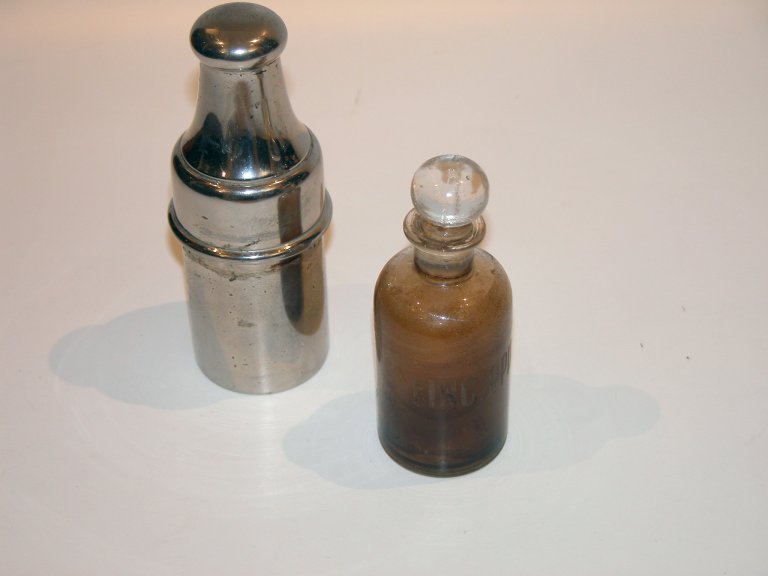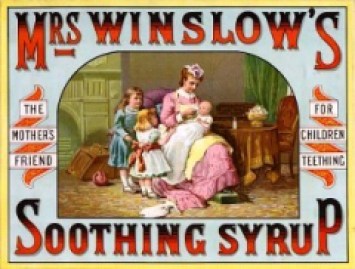Exhibition
Opium
Opium is perhaps the oldest example of a drug that has been used for medicine and recreation, and has been used in this way since antiquity, with its first recorded use believed to be in Mesopotamia over 5,000 years ago. Though laudanum, a solution opium in ethyl alcohol, was popular in the 19th century, opium itself was banned from many countries in the 20th century. However, its derivatives including codeine, morphine and heroin are still manufactured today.

Glass bottle for tincture of opium with metal casing. ‘Tincture of Opium’ is engraved on the side of the bottle
Morphine
In 1804 Friedrich Stertürner isolated morphine from the opium poppy. He found that the product he had discovered induced euphoria and was a far stronger analgesic than opium. He named it morphine after Morpheus, the Greek god of dreams.
In 1874 and 1897, it was discovered that morphine could be refined to produce heroin. This new drug was originally marketed as a cough suppressant (particularly for children!) and as a cure for morphine addiction. Once in the body, heroin metabolises into morphine- an extremely embarrassing discovery for the company concerned! It was more widely used after the introduction of the hypodermic needle. Bela Lugosi, who played Dracula in the 1931 film, is said to have become addicted to morphine in the 1940s after suffering a back injury, though he later managed to overcome his addiction.

A 19th century advert for Mrs Winslow’s Soothing Syrup, aimed at families. One of the major ingredients was morphine
Codeine
This analgesic is also found in the opium poppy. Though it is synthesized from morphine, it is less potent and addictive. It may originally have been prepared in c.1715 by the chemist Lemart in the Netherlands, though it was first isolated in in 1832 in France by Pierre Robiquest.
Howard Hughes’ post mortem showed lethal levels of codeine following his death aged 70 in 1976. After his death, x-rays showed five needles in his arms which had broken off when he injected codeine.
Cocaine
Obtained from the leaves of the coca plant, cocaine was first isolated in 1855 by Friedrich Gaedick and named erythroxyline. It was purified in 1860 by Albert Niemann and renamed cocaine. It first use as an anaesthetic was by Dr Carl Koller who applied a cocaine solution to his eye and then pricked it with pins. Its use as a spinal anaesthetic was discovered by Heinrich Quincke in 1898, who described a technique of lumbar puncture which was later used by August Bier in his experiments on spinal anaesthetic. Addiction to cocaine amongst doctors during the late 19th and early 20th centuries was surprisingly common, with one estimate at 30% of doctors and dentists.
Cocaine can still be used as a local anaesthetic, though rarely and often in combination with other synthesised drugs.

Packaging for cocaine hydrochloride pills for ophthalmic use, manufactured by Burroughs, Wellcome & Co. Ltd, early 20th century
Nitrous Oxide or ‘Laughing Gas’
Though nitrous oxide was first synthesized by Joseph Priestly in 1772, it was then prepared and thoroughly tested by 19 year-old Humphry Davy in 1798. Davy recognised the analgesic properties of the gas and its potential to be used in surgeries, though it was almost fifty years until it was taken up.
Laughing gas parties or ‘ether frolics’ became popular amongst the upper classes from 1799, when nitrous oxide or diethyl ether was inhaled to induce feelings of euphoria.
Since Wells’ first public demonstration in 1844, nitrous oxide has been used as a light anaesthetic and analgesic and is still used as a self-administered analgesic in obstetrics and also in surgery, where it is used as a light anaesthetic before stronger drugs are added.

Poster for laughing gas demonstration at the Adelphi Theatre in 1824
Sodium Thiopental
This rapid onset, shorter-acting anaesthetic is administered by intravenous injection. Ernest H Volwiter and Donalee L Tabern at Abbott Laboratories in the early 1930s. It continued to be manufactured at Abbott until 2004.
Though a more modern drug than those above, it has just a dark and controversial a history as drugs such as opium and morphine.
One alternative use for it is as a truth serum. Doctors using it as an anaesthetic noticed that patients became disinhibited and talkative just before they lost consciousness. As a barbiturate, it slows down the messages that are sent to the brain and slows down the thought process, making it difficult to think clearly and thus to maintain a convincing lie. However, this process also makes the patient more suggestible and not necessarily truthful.
It has also been used as an execution tool. In 34 US states it was used as part of the lethal injection. Ohio was the first state to use a large single dose rather than a three drug cocktail, which also includes Pancuronium and potassium chloride. In 2010, the sole American supplier of sodium thiopental announced that production would stop.
Watch the clip below to discover what happened to BBC presenter Michael Moseley when he tried to convince doctors he was a famous heart surgeon, after a dose of sodium thiopental.